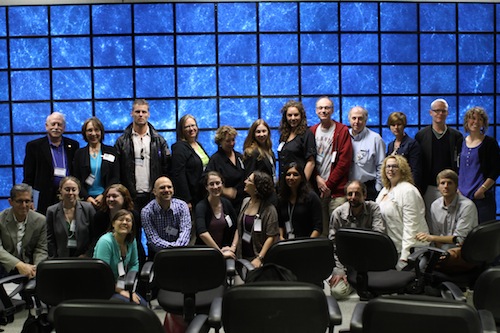
Journalism Boot Camp Participants in front of the NASA Ames Hyperwall.
Photo by Trudy E. Bell view more photos
First Science Journalism Boot Camp in Computational Astronomy Held at UCSC
view a formatted pdf version of this article
What does an Emmy Award-winning film-maker for National Geographic and Smithsonian have in common with a senior editor for the world’s premier Spanish-language science magazine, a reporter for German Public Radio, and writers for Astronomy, Scientific American, Sky & Telescope, CNN.com, and the Los Angeles Times? They all spent four intense days with UC-HiPACC faculty at the first-ever ‘boot camp’ on astrocomputing
Nearly two dozen of the world’s top science and engineering journalists—whose publications and productions collectively reach more than 10 million readers and viewers worldwide—converged onto the campus of the University of California at Santa Cruz for the first “boot camp” on astronomy to be held on the West Coast.
“Computational Astronomy: From Planets to Cosmos,” was an intense three-and-a-half-day backgrounder for practicing science or engineering journalists from all media—print, online, broadcast, social media, and film—whether on staff or freelance. The boot camp was also the first ever to be offered specifically on astrocomputing.
Range of journalists
Applications to the journalism boot camp were accepted from March 1 to 30. The array of journalistic talent who responded was so impressive that the program accepted 21 applicants instead of the originally anticipated 12 to 16.
The group represented all media. It included magazine feature writers for Air & Space/Smithsonian, Astronomy, Chemical & Engineering News, New Scientist, Scientific American, and Sky & Telescope; daily newspaper reporters for the San Francisco Chronicle and Los Angeles Times; and online writers and new media specialists for Physics Today, Popular Science, and CNN.com. Also included was an Emmy Award-winning documentary filmmaker for National Geographic and Smithsonian, a reporter for German Public Radio, and senior writers for two major international periodicals: the largest science magazines in the Spanish language (Muy Interesante, with a worldwide circulation of more than 3 million) and in Eastern Europe (the Czech language weekly Respekt).
The group was rounded out by public information officers from Ohio State University and the University of Florida.
Participants spanned the entire range of journalistic experience from blazing young talents who have been writing professionally for only two or three years (and who thus will be writing for decades to come), to mid- and late-career veterans seasoned with stories, experience, and contacts.
Journalists selected for the 2012 UC-HiPACC Journalism Boot Camp “Computational Astronomy: From Planets to Cosmos”
Rebecca Boyle |
Earle M. Holland |
Camille Carlisle, M.S. |
Amina Khan |
Chad Cohen, M.A. |
Liz Kruesi |
Charles Day, Ph.D. |
Elizabeth Rosa Landau, M.A. |
Katie Detwiler |
Bruce Lieberman, M.S. |
Philip Downey, M.A. |
John Matson, M.A. |
Pam Frost Gorder, M.A. |
Guido Meyer |
Heather Marie Goss |
David Perlman [unable to attend due to sudden illness] |
Lisa Grossman |
Angela Posada-Swafford |
Donna Hesterman, M.S.
|
Martin Uhlir, M.S.
Elizabeth Wilson |
3.5 packed days
The boot camp opened with a welcome reception and introductions Sunday evening, June 24 at the home of UC-HiPACC director Joel R. Primack and his wife, philosopher and writer Nancy E. Abrams.
Sessions the first two full days were held on the campus of the University of California, Santa Cruz, home to UC-HiPACC, the University of California Observatories, the Center for Adaptive Optics, and the Santa Cruz Institute for Particle Physics.
Monday and Tuesday were two full days of intensive “mini-courses” focused on current pioneering investigations in planetary science, stellar astronomy, explosive and high energy astrophysics, dark matter and dark energy, and cosmology, including discussions of instrumentation and analytical techniques. Mini-courses were given by top astrophysics faculty from across the campuses of the University of California system and from the Department of Energy National Laboratories affiliated with UC-HiPACC.
Monday also included an on-campus field trip to the famous University of California Instrument Laboratories and optical shops, plus an evening banquet. Tuesday afternoon concluded with a 90-minute round-table session devoted to discussion of journalistic challenges, such as accurately portraying complex analytical techniques and exciting science when industry pressures are toward ever shorter stories.
Wednesday featured field trips to two institutions leading in astrocomputing and visualization. In the morning, the group traveled to NASA Ames Research Center, Moffett Field, Mountain View, where Christopher E. Henze demonstrated use of the 128-screen Hyperwall of the Pleiades supercomputer. The group continued to the California Academy of Sciences for lunch and a tour of the visualization laboratories, followed by a viewing of two productions in the digital Morrison Planetarium. The day ended with the dress rehearsal for a press conference by B612, a private corporation announcing its intention to build and launch a satellite into solar orbit to monitor possibly threatening near-Earth asteroids.
Expenses of both faculty and journalists were underwritten by UC-HiPACC. Full program with links to a PDF directory of the faculty speakers and participants plus talks and videos is at http://hipacc.ucsc.edu/2012CAJBC_Program.html
- Trudy E. Bell, M.A.